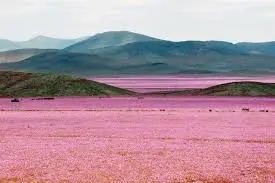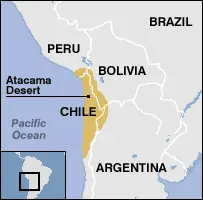The Atacama Desert in Chile, one of the driest places on Earth known for its inhospitable terrain and lack of vegetation has taken meadow form this spring — an event that occurs only once every 10-20 years. It has transformed the dry, brown desert landscape into a lushes “flowering” bed of white and violet colors fascianting both scientists and visitors.
Climate Change and Unusual Rainfall
But the remote occurrence is largely due to unusually heavy winter rains in North Chile during the Southern Hemisphere autumn. About 0.4 inch (11 millimeters) of rain, plus morning fog in mid-April set off a growth spurt from vegetation that can lie dormant up to 15 years. Scientists say climate change could be a key factor in the unexpected occurrence for some of Earth’s driest desert.

The Spectacular Bloom
This year blossomed first some bright fuchsia-pink pata de guanaco and the tiny diaphanous sisyrinchium – sighs of the field. The phenomenon took place in large tracks which accounted for some 30,000 to 40,000 hectares from Arica y Parinacota Region all the way down till Coquimbo (Anton Eitzinger). A full flowering event, which normally occurs from September to October can be as wide as 5800 square miles in size and contain about two hundred species of flowers.
The Role of El Niño
The phenomenon is not entirely new. El Niño cycles, which typically bring above-average precipitation to Chile, are known factors in triggering blooms. This climatic influence is why most flowers in the Atacama bloom during spring, which usually lasts between June and August. But the magnitude and timing of this years blooms is in keeping with a changing climate, as peripheral parts extend into more temperate places.
Implications of Climate Change
Seeing a desert in bloom is an amazing sight, but it also results to questions. In the case of climate change, these types of rare events are expected to become more frequent and can disrupt this finely tuned evolutionary cogs in some annual plants. If the blooms start to happen too often for these plants, which have evolved with extremely low dormancy times, there might be problems as they may not flower more than once a year at best due to their stringent WREW cycle.
Experience the Bloom
The Atacama Desert is currently a must-see destination for those who want to observe this natural wonder. As summer turns to spring in the Southern Hemisphere this week, more bioluminescent flowers could be on display long into their next growing season: a rare and stunning sight that few ever have seen.
Affiliate Links for Desert Enthusiasts
But if you go to Atacama Desert the best thing is checking these products:
Top Desert Adventure Travel Gear: Pack the must-have gear for your traveling comfort and safety in desert.
Photograph Natural Wonders: Use Quality Cameras & More to Shoot the Flowering Desert with a wide range of photo gear.
Atacama Desert Guided Tours: Head here to book expert-led tours and see the Atacama plateau in full bloom.
9 Books on the Deserts – MathomLinksBooks on Desert Flora and Fauna: delving further into how arid biomes function these are some of the most informative, with beautiful pictures too.
The bloom of life in the Atacama Desert reflects nature’s continuing attempt at resilience and starkly outlines what a warming planet can do to it. While we marvel at the beauty of these unique and thankfully by no means doomed, events it gives us pause to consider how little understanding our species has for that which sustains all life on Earth- the culmination of billions upon billions years worth of evolution.


